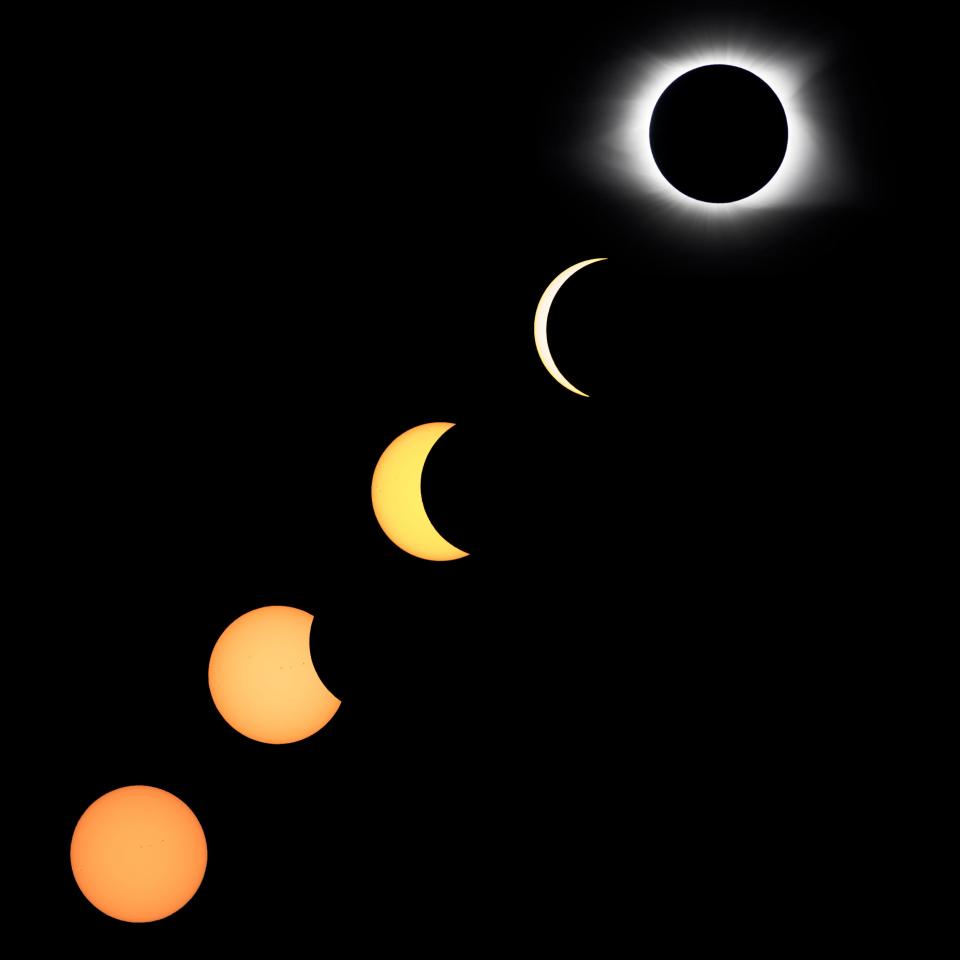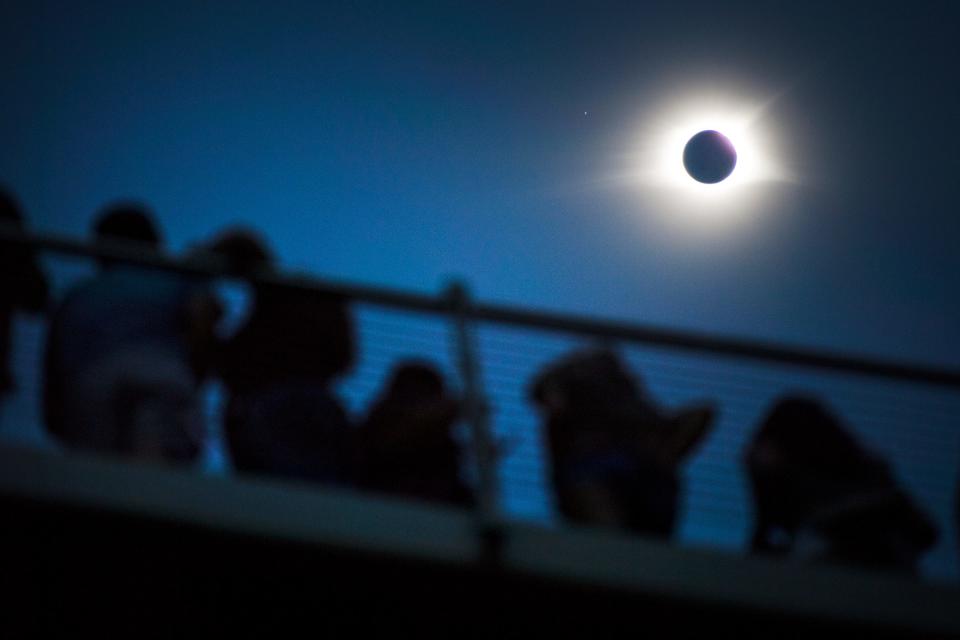A partial solar eclipse is happening Monday. Here are best places to watch in Upstate
This spring's total solar eclipse will be the last one in a long time, so mark your calendars.
The total solar eclipse visible in the United States will occur on April 8. The next total solar eclipse will not be seen in the area until August 2044.
A total solar eclipse occurs when the moon passes between the Earth and the sun, blocking the face of the sun completely, according to NASA. Those viewing the eclipse from its path of totality―locations where the moon's shadow completely covers the sun―will experience a total solar eclipse. During this phenomenon, the sky will be shrouded in temporary darkness as if it were dawn or dusk, and the outer atmosphere of the sun, known as the corona, will be visible.
The last time a total solar eclipse passed transcontinentally was August 21, 2017, the first time since 1918. It took about an hour and 40 minutes to cross from Oregon to South Carolina. In Greenville News archive photos, folks are seen around that time looking through a telescope at Roper Mountain Science Center during an Eclipse Extravaganza.
Before this, the last two total eclipses visible from South Carolina occurred in 1900 and 1970.
This year's total eclipse will be the last one visible in the state until 2029's partial eclipse.
Solar eclipse events stir up much anticipation and excitement for millions of people throughout the nation. However, it is important to remember to practice safety precautions in advance. To view the eclipse, bystanders will want to make sure to purchase safe solar viewers, or "eclipse glasses," to avoid eye injury or blindness caused by the sun's harsh light.
When will the eclipse start? How long will it last?
Total solar eclipses can last anywhere from 10 seconds to 7.5 minutes, according to NASA. In 12,000 years from 4000 BCE to 8000 BCE, the longest total solar eclipse will occur on July 16, 2186, and will last seven minutes and 29 seconds, its trajectory moving from Columbia, Venezuela, and Guyana.
In comparison, the shortest total solar eclipse took place on Feb. 3, 919 CE, lasting only nine seconds.
Since South Carolina will not be in the path of totality, the event will appear as a partial eclipse, visible from 1:48 p.m. to 4:27 p.m. in the state. It will peak in the Upstate around 3:05 p.m., blocking out 85% of the sun.

Where can I watch the eclipse in the Upstate?
The eclipse's magnitude will depend on where you are viewing it in the state, appearing larger in the Upstate and smaller in the Lowcountry and coastal areas.
The following is a selection of cities and the best times to watch the eclipse via eclipse2024.org:
∎ Anderson: 3:08 p.m.
∎ Charleston: 3:08 p.m.
∎ Columbia: 3:10 p.m.
∎ Greenville: 3:09 p.m.
∎ Myrtle Beach: 3:13 p.m.
∎ Spartanburg: 3:09 p.m.
For more cities and times, visit here.

Eclipse safety, where to buy protective glasses
Those who plan on watching the total solar eclipse should proceed with caution. It is not safe to look directly at the sun without specialized protection for solar viewing except during the brief total phase when the moon blocks the face of the bright sun (when you can no longer view the sun through eclipse glasses or a solar viewer, it is safe), according to NASA.
Partial phases of the solar eclipse, which happen before and after totality, must be viewed through safe solar viewing glasses ("eclipse glasses") or a safe handheld solar viewer at all times. Safe solar viewers meet the ISO 12312-2 international standard and are thousands of times darker than regular sunglasses. Discard eclipse glasses or handheld viewers if you notice any signs of damage.
"Viewing any part of the Sun through a camera lens, binoculars, or a telescope that does not have a special-purpose solar filter secured over the front of the optics will instantly cause severe eye injury," according to NASA. "It is strongly advised not to look through these devices while wearing eclipse glasses or using a handheld solar viewer because the concentrated solar rays will burn through the filter, causing serious eye injury." For more safety information regarding the eclipse, visit NASA.
Here are some trusted eclipse glasses sellers:
For a more extensive list, please visit the American Astronomical Society.
Roper Mountain Science Center will have glasses
Although Roper Mountain Science Center will not have eclipse programming on April 8, they are inviting the public to come watch the Starry Night feature "Eclipse: The Sun Revealed" at 6 p.m. and 7:30 p.m. during March. Guests who visit Starry Nights or Afternoons Explorations will get a free pair of eclipse glasses with their admission ticket courtesy of Greenville Water.
Track the eclipse's path of totality
The following major cities in the U.S. will be in the eclipse's 115-mile-wide path of totality:
∎ Dallas, Texas
∎ Idabel, Oklahoma.
∎ Little Rock, Arkansas.
∎ Poplar Bluff, Missouri.
∎ Paducah, Kentucky.
∎ Carbondale, Illinois.
∎ Evansville, Indiana.
∎ Cleveland, Ohio
∎ Erie, Pennsylvania.
∎ Buffalo, N.Y.
∎ Burlington, Vermont.
∎ Lancaster, New Hampshire.
∎ Caribou, Maine
Read the USA Today story below to learn when the eclipse's path of totality will make its way toward these cities.
Nina Tran covers trending topics. Reach her via email at ntran@gannett.com
This article originally appeared on Greenville News: Here's all you need to know about spring's partial solar eclipse

